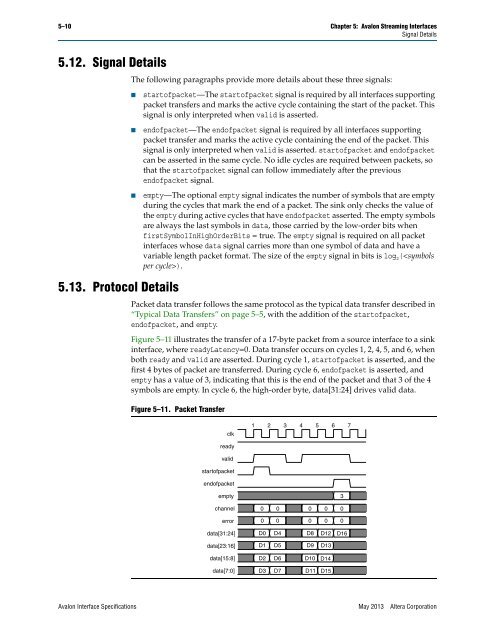Avalon Interface Specifications (PDF) - Altera
Avalon Interface Specifications (PDF) - Altera
Avalon Interface Specifications (PDF) - Altera
Create successful ePaper yourself
Turn your PDF publications into a flip-book with our unique Google optimized e-Paper software.
5–10 Chapter 5: <strong>Avalon</strong> Streaming <strong>Interface</strong>s<br />
Signal Details<br />
5.12. Signal Details<br />
5.13. Protocol Details<br />
The following paragraphs provide more details about these three signals:<br />
■ startofpacket—The startofpacket signal is required by all interfaces supporting<br />
packet transfers and marks the active cycle containing the start of the packet. This<br />
signal is only interpreted when valid is asserted.<br />
■ endofpacket—The endofpacket signal is required by all interfaces supporting<br />
packet transfer and marks the active cycle containing the end of the packet. This<br />
signal is only interpreted when valid is asserted. startofpacket and endofpacket<br />
can be asserted in the same cycle. No idle cycles are required between packets, so<br />
that the startofpacket signal can follow immediately after the previous<br />
endofpacket signal.<br />
■ empty—The optional empty signal indicates the number of symbols that are empty<br />
during the cycles that mark the end of a packet. The sink only checks the value of<br />
the empty during active cycles that have endofpacket asserted. The empty symbols<br />
are always the last symbols in data, those carried by the low-order bits when<br />
firstSymbolInHighOrderBits = true. The empty signal is required on all packet<br />
interfaces whose data signal carries more than one symbol of data and have a<br />
variable length packet format. The size of the empty signal in bits is log 2().<br />
Packet data transfer follows the same protocol as the typical data transfer described in<br />
“Typical Data Transfers” on page 5–5, with the addition of the startofpacket,<br />
endofpacket, and empty.<br />
Figure 5–11 illustrates the transfer of a 17-byte packet from a source interface to a sink<br />
interface, where readyLatency=0. Data transfer occurs on cycles 1, 2, 4, 5, and 6, when<br />
both ready and valid are asserted. During cycle 1, startofpacket is asserted, and the<br />
first 4 bytes of packet are transferred. During cycle 6, endofpacket is asserted, and<br />
empty has a value of 3, indicating that this is the end of the packet and that 3 of the 4<br />
symbols are empty. In cycle 6, the high-order byte, data[31:24] drives valid data.<br />
Figure 5–11. Packet Transfer<br />
clk<br />
ready<br />
valid<br />
startofpacket<br />
endofpacket<br />
empty<br />
channel<br />
error<br />
data[31:24]<br />
data[23:16]<br />
data[15:8]<br />
data[7:0]<br />
1 2 3 4 5 6 7<br />
0 0 0 0 0<br />
0 0 0 0 0<br />
D0 D4 D8 D12 D16<br />
D1 D5 D9 D13<br />
D2 D6 D10 D14<br />
D3 D7 D11 D15<br />
<strong>Avalon</strong> <strong>Interface</strong> <strong>Specifications</strong> May 2013 <strong>Altera</strong> Corporation<br />
3
















